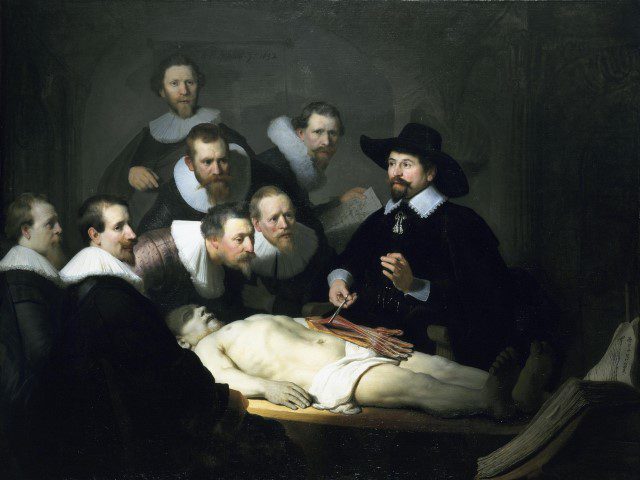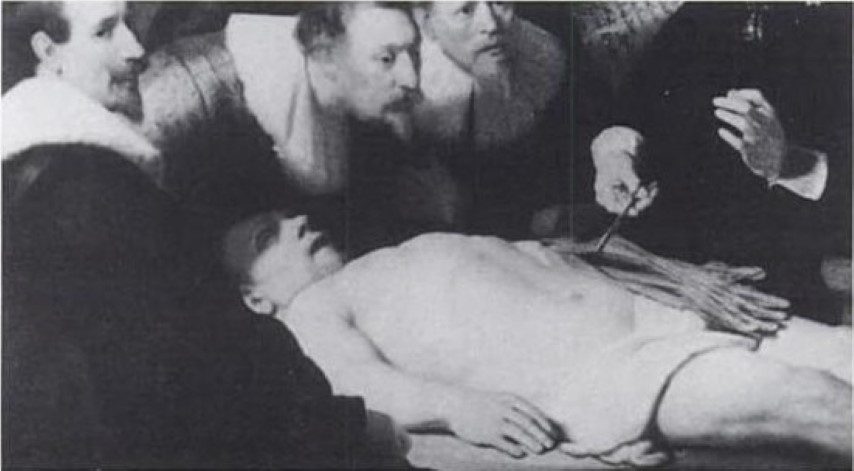Jennifer Xu
Grand Rapids, Michigan, United States

Every January, Dr. Tulp gave anatomy lessons to the Amsterdam Guild of Surgeons at the Waaggebouw amphitheater that “were not only of the greatest interest to a student of medicine” but also of considerable fascination to a larger audience “that saw itself as emerging from the darkness into the light.”2 Rembrandt’s painting depicts one of these public dissections. The body in this particular image was that of Adriaan Adriaanszoon, alias Aris Kindt, a petty thief who “had been hanged for his misdemeanours an hour or so earlier.”3 In the painting, we see that Dr. Tulp holds a pair of dissecting scissors to the body’s left arm, while the seven surgeons surrounding the corpse look eagerly over Tulp’s shoulder.
At first glance, the physicians in the painting—who crane their heads toward the body with expressions of rigorous concentration—represent an epistemological shift toward seeing the body as a perfect specimen for scientific analysis. Yet Sebald’s narrator points to a number of inconsistencies in such a reading. To Sebald’s narrator, this painting does not only represent a demonstration of a new zeal in the sciences; it also bears witness to the horrors of dismembering a corpse, of “harrowing the flesh” of someone beyond death.4 As evidence, the narrator points out that Dr. Tulp has not, “contrary to normal practice,” begun the dissection by taking out the intestines, but rather has started by dissecting the hand with which Kindt had previously used to steal things.5 Furthermore, the surgeons are dressed in their finest clothes, and the narrator imagines they all plan to attend a banquet after the dissection, which adds to the gruesomely celebratory nature of the scene.
What’s more, the narrator asserts that not a single one of Dr. Tulp’s colleagues has noticed the greenish, prone shape of Kindt’s body, nor the fact that his neck is broken. He points out that if we trace the eyelines of the seven surgeons, they seem not to see the body at all, instead deigning to look toward the anatomical atlas in the bottom right corner of the canvas. And it is because of the onlookers’ curious visual relationship to the atlas that we notice something else awry: the “doctoring” of the left hand of the corpse. We come to realize that Rembrandt has taken an anatomical picture from the atlas and superimposed it directly on the left hand—“the exposed tendons, which ought to be those of the left palm, given the position of the thumb, are in fact those of the back of the right hand.”6
The effect of these inconsistencies, the narrator says, is that the human body—the flesh—is rendered invisible to the spectators at the dissection scene. He adds: nobody that afternoon in Amsterdam saw the body on the table—not Dr. Tulp, not the physicians participating in the dissection, not the audience members sitting in the seats of the amphitheatre. They look toward the anatomical atlas and try to make order of the disruption, but instead end up neglecting the material body—they “disregard the flesh, which is beyond our comprehension, and attend to the machine within.”7 In their attempts to compress the flesh into an easily understandable model of Cartesian rigidity, the scientists have managed to make the body vanish altogether.
Though the narrator in The Rings of Saturn asserts quite adamantly that the body has vanished before the eyes of the Amsterdam spectators, it hasn’t vanished for the reader. According to Christian Moser in “Peripatetic Liminality,” “the painting is also, in a self-referential turn, about the act of seeing.”8 For one thing, though the anatomical atlas is the center point of focus for the surgeons at the dissecting table, the book is conspicuously cut out of the reader’s perspective. Rather, our central point of reference is the corpse of Aris Kindt, which highlights an operative difference between what Rembrandt wants us to see and what actually happened that day in Amsterdam: “The map, which is of central importance to the surgeons, is placed at the painting’s margin, whereas the victim’s body, which is marginal to them, is transferred to the painting’s center.”9 Furthermore, the narrator points out that Rembrandt does not represent Kindt’s suffering condition by showing the corpse as it really is with all of its bodily wounds and cuts. Instead, he covers the wounds up and opts to cut up the atlas. The painter clips out—dissects—one of the illustrations from the atlas and superimposes the clip on the site of the bodily wound. Therefore, the narrator asserts that we, as viewers, are able to simultaneously identify with the suffering body due to its central placement in the frame of the painting and perceive, in the cartographic representation of the hand, what the surgeons at the dissecting table saw. He further points out that the wrongness of the scene is highlighted by Rembrandt’s purposeful enlargement of the cartographic hand disproportional to the one that is not being dissected. The purposefully schematic portrayal of the hand on the table has the simultaneous effect of disrupting the verisimilitude of the scene and of ironically reiterating its own criticism of the Cartesian tendency to replace the real by its abstract representation.

Taken further, we can draw an analogy between the painting’s reception and the body’s dissection. In its medical sense, a dissection suggests the methodical division of an animal body for the purposes of “critical examination.”10 The surgeons in the Rembrandt painting are “dissecting” the body of Aris Kindt. But it seems that the more they dissect it, the less it resembles a body and the more it resembles a schematic diagram. In The Body Emblazoned, Jonathan Sawday says that “anatomization takes place so that, in lieu of a formerly complete ‘body,’ a new ‘body’ of knowledge and understanding can be created. As the physical body is fragmented, so the body of understanding is held to be shaped and formed.”11 Sawday sees the act of cutting up of a body as a portal into the development of new “body”: a “body” of knowledge. Yet, Sawday adds, “the ‘thing’—the secret place, the core of bodily pleasure or knowledge of the body—always escapes representation.”12 We can never really “know” the interiors of a body intimately; that information is always encountered secondhand, whether through an X-ray, a photograph, or an anatomical demonstration.13 To bring this back to the Rembrandt painting, Sebald’s narrator argues quite insistently that the surgeons are neglecting the physical flesh in favor of the theoretical realm, to the point that they even mentally superimpose the drawing from the anatomical atlas onto the left forearm of the corpse on the table. The surgeons’ determinedly theoretical view of what the body represents ends up causing the body to vanish altogether.
William Heckscher astutely points out that the Rembrandt painting represents the difference between elucidare—to explain, represented by the surgeons gazing determinedly at the anatomical atlas as a way to unlock the “machine within”—and illustrare—to illuminate, represented by the traumatized body taking center stage on the dissecting table.14 Sebald appears to be urging for an interpretative methodology that illustrates rather than elucidates. This idea is confirmed by the fact that the most evocative portrayals of what it means to be traumatized lie not with academic analyses or public dissections, but a visual image.
Toward the end of the chapter, the author displays the painting again, this time without commentary. The reproduction simultaneously zooms outward and crops Dr. Tulp and the rest of the surgeons out of the image, as if the spectator had taken a step backward and narrowed the viewfinder on his camera.15
The body, now reduced in size, is the only thing that remains in our field of vision. This time, the book is completely cut out, as are the faces of most of the doctors. Such a movement, which recalls the narrator’s paraphrase of a Thomas Browne quote a few pages afterward: “the greater the distance, the clearer the view,” could not be a clearer entreaty for us to focus exclusively on the body.16 Though we see the body from a further vantage point, the distance somehow puts everything in focus. Sebald seems to suggest that in order to understand the experience of being traumatized, we don’t need to look for the answer in the text, theory, or even a close-up of the painting. All we need is a small rectangle of a suffering body being sliced open by a pair of dissecting scissors.
Notes
- van Rijn, Rembrandt. “The Anatomy Lesson of Dr. Nicolaes Tulp,” oil on canvas, c. 1632 (The Hague, Mauritshuis).
- Sebald, W G, and Michael Hulse. The Rings of Saturn. (New York: New Directions, 1998), 12.
- Sebald, The Rings of Saturn, 12.
- Sebald, The Rings of Saturn, 12.
- Sebald, The Rings of Saturn, 16.
- Sebald, The Rings of Saturn, 16.
- Sebald, The Rings of Saturn, 13.
- Moser, Christian. “Peripatetic Liminality: Sebald and the Tradition of the Literary Walk.” The Undiscover’d Country: W.G. Sebald and the Poetics of Travel. By Markus Zisselsberger. (Rochester, New York: Camden House, 2010), 51.
- Moser, “Peripatetic Liminality,” 51.
- “dissection, n.”. OED Online. December 2013. Oxford University Press.
- Sawday, Jonathan. The Body Emblazoned: Dissection and the Human Body in Renaissance Culture. (London: Routledge, 1995), 2.
- Sawday, The Body Emblazoned, 12.
- Sawday, The Body Emblazoned, 7.
- Heckscher, William. Rembrandt’s Anatomy Lesson of Dr. Nicolaas Tulp: An Iconological Study. (New York: New York University Press, 1958), 63.
- Sebald, The Rings of Saturn.
- Sebald, The Rings of Saturn, 19.
JENNIFER XU is a freelance journalist and medical student at the University of Michigan Medical School. She is a contributor to The Atlantic and has been interviewed on the NPR show “Stateside” with Cynthia Canty.
Highlighted in Frontispiece Volume 8, Special Issue – Summer 2016

Leave a Reply